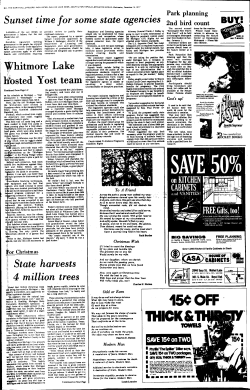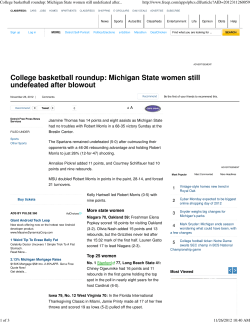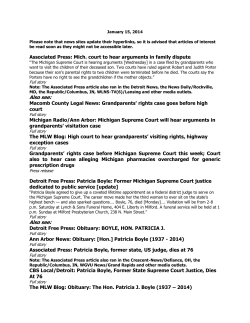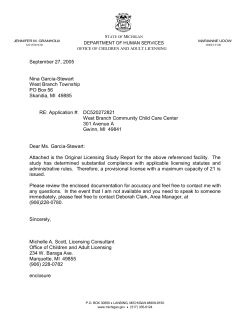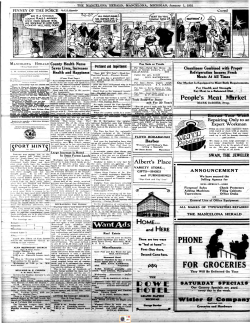
THREE FIRES T Mitten
The Mitten A Publication of Michigan History magazine SEPTEMBER 2001 THREE FIRES THE T traders. They also made excellent bark canoes that helped them trade all over North America. The Odawa lived along the eastern shores of Lake Michigan. When the French arrived in the Great Lakes the Odawa had around 3,000 people. The Potawatomi were called “the people of the place of the fire.” They were some of Michigan’s earliest farmers. The Potawatomi grew squash, corn, melons, beans and tobacco. Their villages were larger and more permanent than those of the Ojibway and Odawa. There were about 4,000 Potawatomi living in Michigan during the mid-1600s. This painting shows Native Americans living near present-day Sault Ste. Marie. The bark-covered houses shown here are called wigwams. Royal Ontario Museum he three tribes most commonly associated with Michigan are the Ojibway (Chippewa), the Odawa (Ottawa) and the Potawatomi. These three tribes were like members of a family. The Ojibway were the “older brothers.” The Odawa were the next born and the Potawatomi were the “younger brothers.” These three tribes formed the Three Fires Confederacy, also known as the Anishinabek. A confederacy is a loose-knit alliance that promotes common interests. Ojibway means “to roast ‘til puckered up” and describes the unique style of moccasins these Native Americans wore. The Ojibway, a tribe of around 30,000 people, lived along the southern shores of Lake Superior and western Lake Huron. The Ojibway were excellent hunters and fishermen. Odawa means “to trade.” The Odawa were skilled Native American Life I Michigan State Archives of n the mid-1600s, nine Native American tribes lived in the Great Lakes area. They totaled around 100,000 people. The largest tribe was the Huron, who lived in the region between Lakes Erie, Ontario and Huron. Tribes living in the area that is now Michigan included the Three Fires: the Ojibway, the Odawa and the Potawatomi. Other area tribes were the Menominee, the Sac (also Sauk), the Fox, the Winnebago and the Miami. Each tribe was different, but they all shared three beliefs: 1) Spirits were more powerful than men; 2) Nature—the land, animals and plants— belonged to everyone and 3) No one had the right to run another person’s life. Everyone living in an Indian village worked. Women and girls did most of the chores. They tanned (softened) animal skins, wove fishnets, chopped wood, grew crops and cooked. Men and boys hunted and fished. They made bows and arrows, traps, wooden tools and canoes. Unlike Native Americans who lived on the Great Plains, Michigan Native corn, beans and squash in gardens. They also hunted. Men and boys used traps and snares, as well as bows and arrows, to take bear, moose, deer, wolf and fox. Michigan Native AmeriAmericans did not live in cans did not wear feathered tepees. Most lived in domeheaddresses. They wore their shaped houses called wighair long. Sometimes they wams. Saplings were stuck braided their hair. In the into the ground and tied summer, Native Americans together to create a frame. wore only a breechcloth Sheets of bark taken from and moccasins. During cold large trees were placed over weather both men the saplings. When a family and women wore fur hats, moccasins, leggings and shirts. Women also wore knee-length deerskin skirts. Today, many places in Michigan have Native American names. The word Michigan The birch-bark canoe comes from an moved to a new was a remarkable Indian language. place, they rolled invention. The canoe “Michi” means up the bark coverwas strong, waterproof and lightweight. great; “gane” ing and took it with means lake or them. They left the water. But Native Americans sapling framework behind. gave Michigan more than Michigan Indians names. They taught obtained food in many ways. Michigan’s first white people From the forests and lakes how to live in the wilderness, they gathered berries, nuts make canoes and hunt. and wild rice. They grew LEARN MORE ABOUT THE THREE FIRES t Darryl Meredith The MUSEUM OF OJIBWA CULTURE in downtown St. Ignace has exhibits on the Native American ways of life. The museum’s resident Chippewa artist, Ron Paquin, demonstrates how he makes birch-bark canoes and baskets. For information, write to 566 North State Street, St. Ignace, MI 49781. Telephone (906) 643-9380 or visit on-line at www.stignace.com/attractions/ojibwa. The MICHIGAN HISTORICAL CENTER offers exhibits on Native Americans in the Great Lakes area. On display are arrowheads, trade goods and a birch-bark canoe. The museum is located at 717 West Allegan, Lansing, MI 48918. Telephone (517) 373-3559, TDD: (800) 827-7007 or visit on-line at www.sos.state.mi.us/history. The Creation of Sle eping B ear Dun es he people of the Three Fires had many stories about how the world was created by the Great Manitou, or Great Spirit. One of the stories is about how North and South Manitou Islands and Sleeping Bear Dunes were made. A mother bear and her two cubs lived peacefully on the western shore of Lake Michigan. They ate berries and fish and drank from the T Places in Michigan with Native American names lake. The mother bear MICHIGAN = great lake taught her cubs to be CHEBOYGAN = Chippewa water thankful to the Great KALAMAZOO = reflecting river Manitou for all things. ISHPEMING = heaven One summer night MUNISING = island in a lake there was a big thunderPETOSKEY = rising sun storm. Lightning set the ESCANABA = flat rock forest on fire. The mother bear gathered her cubs and jumped into the lake to escape slept, the Great Manitou whisthe flames. All through the pered to her. “Because you night they swam toward the always remembered me with distant shore, away from the thanks, I will take you to the fire. The cubs grew tired. Land of the Spirits. Your cubs First, the younger one are already there.” sank beneath the The Great Manitou creatwaves, then the older ed two islands to honor the cub disappeared. brave bear cubs. He called The mother them North and South bear could not Manitou Islands. The Great save them. She Manitou then covered the made it to mother bear with a blanket of shore and fell white sand. Today she rests into a deep sleep under Sleeping Bear Dunes. on the beach. As she What Did You Learn? * 1. BONUS: Which Native American group was known as skilled traders? 2. What did Native American women and girls do? a. Potawatomi a. make bows and arrows b. tan animal skins c. catch fish b. Menominee c. Odawa Vocabulary WORDS 9 Great Plains: Prairie land in the middle United States breechcloth: Square leather pieces worn over the front and back of the hip area What does the word Potawatomi mean? a. people of the place of the fire b. growers of corn c. big lake 3. Most Native Americans in Michigan lived in houses called ____________________. 4. The _________________ Indians lived in southern Michigan and were good farmers. Q M C H K E B A N H S I N A N N T E Z S J P D O I M O T A W A T O P V A O J W F leggings: Leather pants N W N D H F M I O X P T O W B H F Z A I alliance: People joined together in purpose or beliefs J saplings: Young trees Q G C W G C X M I P T Q X W E L U T Z U The Mitten is produced by the staff of Michigan History magazine, which is part of the Michigan Historical Center. The Michigan Historical Center is part of the Department of History, Arts and Libraries. Dedicated to enhancing the quality of life in Michigan, the department also includes the Mackinac Island State Park Commission, the Library of Michigan, the Michigan Film Office, and the Michigan Council of Arts and Cultural Affairs. For more information, contact Michigan History at (517) 373-3703 or visit us on-line at www.sos.state.mi.us/history/mag J Q A A W K S J S I H L N S D P U U Y W U H A P H W Q B V D H O P S S N G N F B I Y C A N O E W R Y N I R P J G O M L W S J M Q A S G A P S S Q G B WN J K D Z H J I K S K G Y NM O C C A S I N J S N R T H R E E F I R E S V D OGC A Z H Find the following NATIVE AMERICAN words ANISHNABEK OJIBWAY ODAWA POTAWATOMI THREEFIRES CANOE SNOWSHOE MOCCASIN
© Copyright 2025

